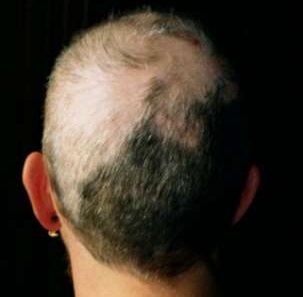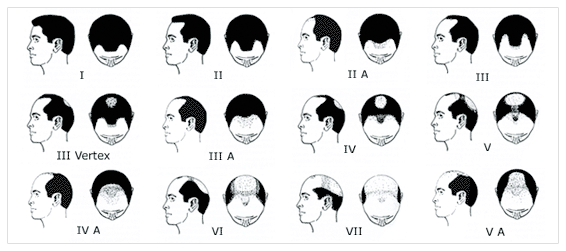Nobody likes losing their hair. It doesn’t matter if you’re 20 or 75, a man or a woman, gay or straight. But most of us will experience some degree of hair loss during the course of our lives. Here is your basic guide to balding, complete with pertinent statistics, diagnostic criteria, treatment options, and much more.
Statistics
The statistics on balding vary widely, as a surprisingly small number of male pattern baldness-related studies have been performed. For instance, the American Hair Loss Association asserts that ⅔ of men have some degree of “appreciable hair loss” by the time they reach the age of 35 (source). So, basically that would mean that everyone goes bald to some extent.
On the other hand, The ISHRS, or International Society of Hair Restoration Surgery, states that men have approximately a 20% chance of hair loss in their 20s, a 30% chance of hair loss in their 30s, a 40% chance in their 40s, and so on -- all the way up to a 90% chance of hair loss in their 90s (source). The Bosley blog cites similar statistics, claiming that 20% of men show symptoms of male pattern baldness by the age of 20, and that 50% of men start losing their hair by the age of 50 (source).
Some disagree, though. The distinguished William R. Rassman of baldingblog.com, along with a number of other hair restoration surgeons, frequently contend that only about half of all men inherit the balding gene (source).
So who’s right? I’ve reviewed the opinions and statements of countless hair loss companies, organizations, and surgeons. And I believe the ISHRS’s figures are roughly accurate, and that men have approximately a 20% chance of experiencing male pattern baldness in their 20s, a 30% chance in their 30s, and so on. I'm a 31-year-old guy, so I know many men in their early to mid thirties -- and I personally don't think there's any way that 2/3 of 35-year-old men are balding, as the American Hair Loss Association seems to claim, but I could be mistaken.
Cause & General Truths
Male pattern baldness is an inherited trait that causes hair follicles to shrink and eventually die (source). The process involves a hormone called dihydrotestosterone, or DHT. If your scalp hair follicles are sensitive to DHT and you have a genetic predisposition to the baldness gene, then you’ll eventually lose at least some of your hair.
Most experts agree that severe cases of male pattern baldness typically begin when men are in their late teens or early 20s (source). However, there are plenty of exceptions to this rule. You could retain a full or relatively full head of hair into your 50s, then lose it all rapidly, like the piano man, Billy Joel did.
When it comes to hair loss, how fast the process goes and where it stops, nobody knows. That said, if you keep your hair until you reach the age of 35 or so, then you’ll most likely experience a more mild and treatable form of hair loss in comparison to the men who start balding at an early age. The balding process usually takes about 15-25 years to complete -- or at least to stabilize.
How to Tell if You’re Balding
Thinning at the hairline corners -- around the edge of your eyebrows -- is often the earliest sign of hair loss. An adult-male hairline, or mature hairline, is usually v-shaped, whereas a juvenile hairline is relatively straight.

Richard Nixon had a prominent receding hairline of the "island" variety.
Comparatively, a receding hairline will often appear to be M or U shaped. Tom Hanks is a good example of a celebrity with a reasonably mild, M-shaped, receding hairline. There’s also the more dramatic, “island” variety of balding, where the central forelock remains in tact but the corners recede completely (or almost completely), leaving nothing but an island of hair in the middle. Judd Law has sported the island look for years, as has the singer Sting, among many others. The process can also begin in the back, at the crown of your head.
Still not sure if you’re losing your hair? Try asking an experienced barber. Sure, you could seek a diagnosis from the cute Asian gal who cuts your hair at Great Clips, but chances are, any decent barber will be exponentially more knowledgeable on the subject of hair loss than she is. Moreover, most seasoned barbers have seen every balding pattern hundreds of times! If you’re feeling courageous, shaving your head is another option, as doing so will reveal your true hairline -- for better or for worse.
Finally, if you truly want an official and proper diagnosis, you can get a bulk hair analysis and/or miniaturization exam done for a fairly reasonable price (or perhaps even for free). These tests scientifically evaluate the density of your hairs throughout your scalp in comparison to your “permanent” hair zone at the back of your head. By having an exam performed, you can know for certain if you're losing your hair or not, even if you have no thinning that's visible to the naked eye.
Other Common Signs of Hair Loss
- Abnormal shed on your pillow -- we’re talking more than just a few hairs per night.
- Losing many hairs in a particular area while combing -- say around your hairline corners or crown.
- Excessive hair build-up in your shower drain -- Maybe your mom, wife, or girlfriend is starting to use the drain-o a little more often.
- Hair that looks “chewed-out” or ragged in appearance -- this often occurs at the front of the hairline.
- Losing clumps of hair when you put your hands through it -- a common sign of early, aggressive male pattern baldness.
- Lighter, smaller, and shorter hairs -- They'll start growing in areas that were once populated by “normal” or terminal hairs when you're balding.
- A scalp sun burn -- That's unlikely to happen to someone with a full head of hair.
- Difficulty achieving or maintaining hairstyles that previously worked for you -- maybe the part is getting wider and more noticeable.
More on the Mature Hairline
Many young men mistake a maturing hairline for male pattern baldness. Between the ages of approximately 17 and 29, nearly all men will see their hairline "mature" to some degree. That means their frontal hairline moves back about ½ to 2/3 of an inch (or about 1 to 1.6 cm), as do the corners of their hairline, which creates a slightly “receded” appearance. Only about 5% of caucasain men enjoy their youthful, rounded, juvenille hairlines for life.
The mature hairline can take a few years to fully lock into place, and the process involves slow and mild, often unnoticeable thinning. Examples of celebrities with mature hairlines include Leonardo Dicaprio, Jon Hamm, and Ryan Reynolds.
The Norwood Scale
The Norwood Scale, as shown above, has been the hair loss industry’s preferred baldness barometer since the 1970s. It depicts the seven most commonly observed patterns of hair loss, along with a few variations. Type I is a juvenile hairline, type II is the mature hairline, and pattern II A is considered the first official stage of balding.
Top 3 Hair Loss Myths
- Your maternal grandfather is to blame (it can come from either side)
- Over shampooing or over styling your hair can cause baldness
- Wearing a hat too often can accelerate or lead to hair loss
One Scary Stat
By the time you can actually see thinning with your naked eye, you’ve probably already lost about 50% of your hair in that particular region (source). This isn’t meant to send you into a panic mode! But if you’re truly concerned about your hair loss or the possibility thereof, taking a proactive course could be a wise decision.

Other Types of Hair Loss
Roughly 95% of all cases of hair loss in men are related to androgenic alopecia, or male pattern baldness. Severe stress, extreme weight loss, and a variety of other mental and physical conditions can also lead to hair loss, as can certain medications like statins and antidepressants. The public domain picture to the left shows a young man with trichotillomania, which is an affliction defined by recurrent attempts to pull out hair from one's scalp, eyebrows, or other part of the body. Pulling back your hair too frequently and/or tightly can also lead to a type of hair loss known as traction alopecia -- so if you currently sport a man bun, please tie it with care.
Hair Loss 101 - Summary
- Men have approximately a 20% chance of experiencing some degree of balding in their 20s, a 30% chance in the 30s, 40% in their 40s, and so on.
- The earlier the process starts, the more aggressive it is, in most cases.
- Male pattern baldness is an inherited trait that causes your hair follicles to shrink as a result of DHT exposure.
- The gene can come from either your mother or father’s side.
- Most men will develop a mature hairline between the ages of 17 and 29.
- Common signs of hair loss include excessive shed on your pillow, hair build-up in your drain, and difficulty realizing hairstyles you had in the past.
- There are many treatments available that can slow and even reverse hair loss to a degree, all of which have a variety of risks risks and benefits.
- By the time you notice thinning, there’s a good chance you’ve already lost half of your hair in that area.
- Male pattern baldness is not an illness, and the shaved look is in -- so embracing your genetics is a perfectly viable option.
- Early intervention is key if you want to keep your hair, especially if you’re suffering from an aggressive case of male pattern baldness.
Next Steps
Don’t go crazy and start evaluating your hairline every five minutes, or start taking daily pictures of the back of your head. We’re hypocrites, granted, because we’ve been there and done that! As men, we’re programmed to lose our hair, and it’s likely going to happen to you at some point.
But here’s the good news: this is the best time in history to be a balding man! You have a wide variety of hair loss treatment options available, new and exciting scientific breakthroughs are coming, and moreover, the shaved look has never been cooler. So relax, keep calm, and carry on.
